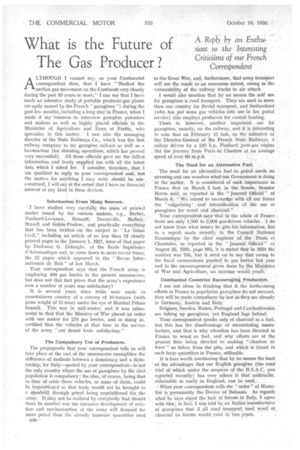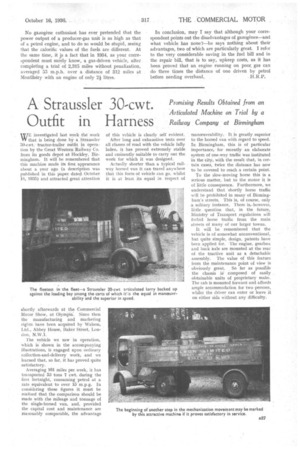What is the Future of The Gas Producer ?
Page 64

Page 65

If you've noticed an error in this article please click here to report it so we can fix it.
A Repij by an Enthul. siast to the interesting Criticisms of our French Correspondent ALTHOUGH I cannot say, as your Continental correspondent does, that 1 have " Studied the suction-gas movement on the Continent very closely during the past 10 years or more," I can say that I have made an intensive study of portable producer-gas plants (so aptly named by the French " gazogenes ") during the past few months„ including a long stay in France, when I made it my business to interview gazogene patentees and makers as well as highly placed officials in the Ministries of Agriculture and Eaux et Forets, who specialize in this matter. 1 saw also the managing director of the State Railways Co., which Was the first railway company to try gazogene railcars as welt as a locotracteur (for shunting operations, which has proved very successful). All these officials gave me the fullest information and freely supplied me with all the latest data which I asked for. I consider, therefore, that I am qualified to reply to your correspondent and, lest the motive for anything I may write should be misconstrued, I will say at the outset that I have no financial interest of any kind in these devices.
Information From Many Sources,
r have studied very carefully the mass of printed matter issued by the various makers, e.g., Berliet, Panhard-Levassor, Renault, Decauville, Malbay, Brandt and Gohin-Poulenc, and practically everything that has been written on the subject in " Le Genie Civil," including an article of no less than 13 closely printed pages in the January 1, 1927, issue of that paper by Professor G. Delanghe, of the Eeole Superieure d'Aeronautique and, to come down to more recent times, the 22 pages which appeared in the "Revue Internationale de Bois " of last March.
Your correspondent says that the French army is employing 400 gas lorries in the present manceuvres, but does not that fact prove that the army's experience over a number of years was satisfactory?
It is several years since trials were made in mountainous country of a convoy of 10-tonners (with gross weight of 15 tons) under the eye of Marshal Petain himself. This was in mid-winter, and it was subsequent to that that the Ministry._ of War placed an order with one maker for 270 gas lorries, and in doing so, certified that the vehicles at that time in the service of the army " ont donne toute satisfaction."
The Compulsory Use of Producers.
The propaganda that your correspondent tells us will take place at the end of the -manceuvres exemplifies the difference of methods between a democracy and a dictatorship, for Italy—quoted by your correspondent—is. not the only country where the use of gazogeries by. the civil population is compulsory ; the idea, of course, being that in time of'crisis these vehicles, or some of them, could be requisitioned so that trade would not be brought to
a standstill through petrol being requisitioned for the . . . . army. It May not be realized by everybody that should there be another war the intensive development of aviation and mechanization of the army will demand far more petrol than the already immense quantities used in the Great War, and, furthermore, that army transport will use the roads to an enormous extent, owing to the vulnerability of the railway tracks to air attack.
I would also mention that by no. means the sole use for gazogenes is road transport. They are used in more than one country for fluvial transport, and Switzerland (who has put some gas vehicles into use in her postal service) also employs producers for central heating.
There is, however, another important use for gazogenes, namely, on the railway, and it is interesting to note that on February 17 last, on the initiative of the Director-General of the French State Railways, .a railcar driven by a 210 h.p. Panhard poor-gas engine did the journey from Paris-to Chartres at an average speed of over 69 m.p.h.
The Need for an Alternative Fuel.
The need for an alternative fuel to petrol needs no stressing and one wonders what Our Government is doing . in the matter. It is considered of such importance in France that on March 3 last, in the Senate, Senator Neroii said, as reported in the Journal Officiel " of March 4; "We intend to encourage with all our forces the ' vulgarizing ' and intensification of the use of gazogenes for wood and charcoal."
Your correspondent says that in the whole of France there are only 1,500 to 2,000 gas-driven vehicles. I do, not know from what source he gets his information, but in a report made recently to the Council National. Economique by the chief engineer of the Fonts et Chaussees, as reported in the " Journal: °facie " cf August 26, 1936, page 885, it is stated that in 1934 the number was 700, but it Went on to say that owing to the fiscal exoneration s granted. to gas lorries last year and to the encouragement given them by the Ministries of War and Agriculture, an increase would Jesuit.
Continental Countries Encouraging Production.
am not alone in thinking that if the forthcoming efforts in France to popularize gazog'enes do, riot succeed. they vill be made compulsory bylaw. az they are :already in Germany. Austria and Italy.
Belgium, Sweden, Russia, Portugal and Czechoslovakia are taking up gazogenes, yet England lags behind.
Your correspondent speaks only of charcoal as a fuel, but this has the disadvantage of necessitating manufacture, and that is why attention has been directed in France to wood as fuel, and why efforts are at the present time being directed to making " charbon de terre " as taken from the pits, and which is found in such large quantities in France, utilizable.
It is here worth mentioning that by no means the least of the advantages that our English gazogene (the road trial of which Under theauspices of the R.S.A.C. you reported recently) has over others is that anthracite, obtainable so easily in England,: can be :used.
What your correspondent calls the order" of Mussolini is presumably the. Decree of BoIzaart. As regards what he says about the lack of forests in Italy, I agree with him; in fad, I was told by an Italian manufacturer of gazogenes that if all road transpoti. used wood or charcoal no forests would: exist ia two, yep.r.s.
No gazogene enthusiast has ever pretended that the power output of a producer-gas unit is as high as that of a petrol engine, and to do so would be stupid, seeing that the calorific values of the fuels are different. At the same time, it Is a fact that in 1934, as your correspondent must surely know, a gas-driven vehicle, after completing a trial of 2,315 miles without penalization, averaged 55 m.p.h. over a distance of 312 miles at NIontlhery with ai engine of only 21 litres. In conclusion, may I say that although your correspondent points out the disadvantages of gazogenes—and what vehicle has none?—he says nothing about their advantages, two of which are particularly great. I refer to the very considerable saving in the fuel bill and in the repair bill, that is to say, upkeep costs, as it has been proved that an engine running on poor, gas can do three times the distance of one driven by petrol before needing overhaul. .H.R.P.








































































































